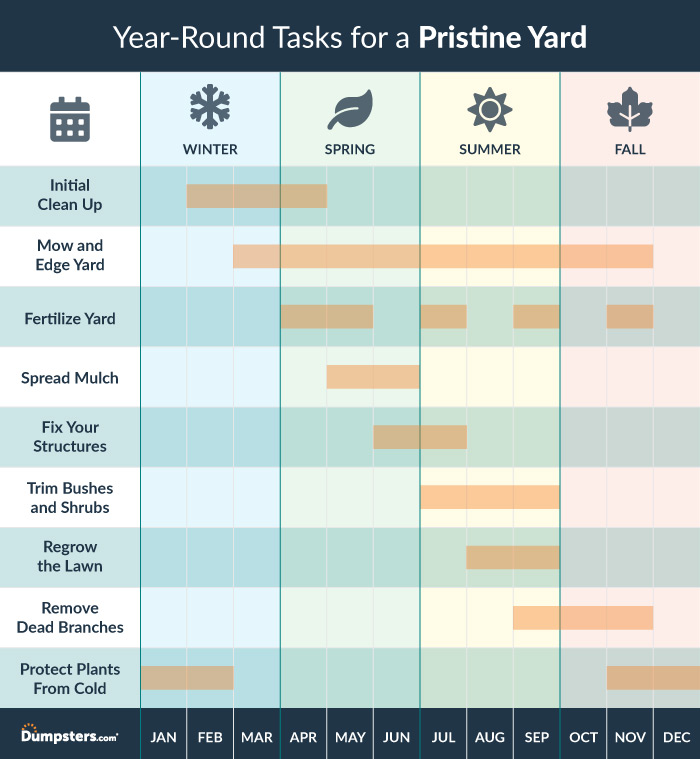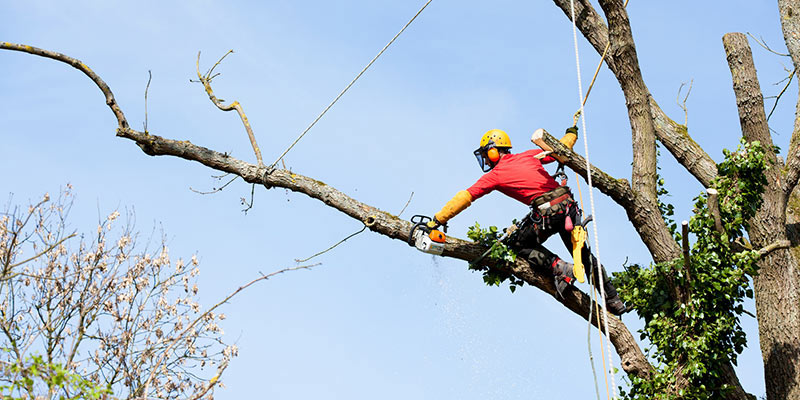
A well-manicured lawn and lush landscaping does more than boost your home’s curb appeal - it gives you and your family a beautiful outdoor space to enjoy.
While a home improvement project like installing new kitchen cabinets is a one-time job, your lawn requires constant and regular upkeep. With attention and proper care, you’ll have the greenest lawn in the neighborhood. Our guide will give you year-round yard cleanup tips with expert advice from Fiskars, Ugly Duckling House, Natureworks and Pennington.
If you’re looking to completely overhaul your landscaping, the national average cost with help from a professional company is $13,200 for a 1,200 square foot yard.
However, if you’re just looking to hire a company to do basic weekly yard maintenance tasks like mowing and weed-whacking, the average cost is $55 per visit. Assuming you need to mow your lawn 30 times a year (roughly every 10 days for nine months), that comes out to $1,650 per year. That cost will rise when you add on other common tasks like leaf blowing, hedge trimming and weeding.
If you prefer to go the DIY route, you can cut the price of yard maintenance to as low as the cost of your tools and materials. In fact, if all things go according to plan, the national average for DIY landscaping comes out to $1,400 annually. This total includes gas for your tools and a tune-up for your lawn mower and other items that require regular service.
Missy Pfeil at Fiskars says the most essential lawn cleanup tools to keep your yard looking fresh throughout the year are:
Keeping your yard clean is a tough job. It’s hard to know which tasks are the most important, when to do them and the best tools to use.
We’ve bundled up the eight most important yard cleanup tasks to do each year, listed in order of the seasons starting with spring.

Clean Up | Mow and Fertilize | Spread Mulch | Fix Structures | Touch-Up Bushes | Regrow Lawn | Trim Dead Trees | Protect From Cold
You’ve had a season off from most yard work in the winter, but now it’s time to catch up. This is the time to clear leftover leaves, fallen branches and weeds, and remove dead shrubs, bushes and trees.
To keep your lawn healthy, you need to feed and trim it on a regular basis. For the best results, it’s important to know the proper methods to care for your grass.
Pro-Tip: The best times to fertilize are in April, around Memorial Day, around July 4, after Labor Day and near the time of your final mow.
When your mulch is looking thin, it’s time to pack some more on. While it doesn’t need to be part of your yearly spring yard cleanup, a fresh layer of mulch instantly makes your yard look revived. Keep in mind that mulch can spruce up more than just flowerbeds and tree patches.
“The mailbox and front garden areas can offer a lot of curb appeal for the money in a single afternoon,” said Sarah Fogle, founder of Ugly Duckling House. “That’s where I begin to add some color and wake things up.”
“Weed, fertilize and add mulch just before spring blooms start coming in. It can do wonders to make the yard look crisp, tidy and ready for long warm days!”
Sarah Fogle | Ugly Duckling House
If you have a deck, hardscape patio, fence or shed, it should be checked yearly for safety and cosmetic issues and repaired as needed. The key is to not jump on the fixing bandwagon too early. You want to wait until your lawn has dried up a bit from the winter snow and spring rains. That way your yard has time to settle and then you can plan your structure cleanup.
Pro-Tip: Keep in mind that sometimes a deck is beyond repair or your shed needs to be torn down. In these cases, rent a demolition dumpster to handle the cleanup.
Some experts recommend trimming your shrubs before they bloom in the spring to see dead spots. Others say to wait until your shrubs have bloomed and grown for the season so you can shape and trim them. Either time works — it all depends on your personal preference.
Your lawn takes a beating throughout the year, and patches are inevitable. Whether you have a small section to replace or need to cover a large area, clear the leaves first and be gentle while removing leaves from the newly-grown lawn as the roots are still shallow.
“The important thing to remember about ongoing lawn care is that grass is a plant,” said Jillian Shea of Natureworks. “It benefits from healthy soil and the right set of growing conditions.”
This is also a good time to consider overseeding, which is the practice of adding seeds to areas that are thinning to help thicken the lawn.
“The best time for overseeding cool-season grasses in northern regions is late summer to early fall, when they’re growing most vigorously. The warm soil encourages seed germination, cool fall air stimulates growth and soil moisture stays more consistent.”
Pennington

While this is a year-round maintenance job, the time to get this yard task done (particularly in the northern U.S.) is before winter. The weight of snow on dead branches and trees can be enough to cause them to fall, which may damage your property.
Safety-Tip: Removing a tree is dangerous. Hiring a professional is recommended for medium and large trees, as well as anytime you don’t feel comfortable performing a task.
While a lot of foliage can handle the cold weather on their own, there are some that need protection. Various shrubs and smaller plants need to be covered from the snow and bitter frosts to look great in the spring when the weather warms back up.
Pro-Tip: If possible, construct a frame and tie the cover to it to prevent the barrier from touching the plants.
Whether you do all of the tasks for yard cleanup and maintenance or pick and choose the ones that best fit your schedule, you hard work will go a long way. The more you stay current with your landscaping cleanup efforts, the easier it gets year after year. And that means you have more time to enjoy the fruits of your labor.
Looking for other outdoor tasks to keep your yard looking its best? Check out our guide on clearing brush, tips for a total lawn renovation and how to remove a concrete patio.
